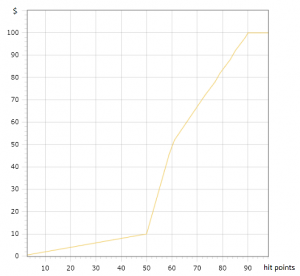Difference between revisions of "Market Value"
Jump to navigation
Jump to search
(Undo revisions - the section changed isn't about how value changes as it deteriorates, its about WHAT decreases in value as it deteriorates. What are the rules that decide that guns get cheaper but drugs do not? Exactly which items is that true for? etc.) |
m |
||
| Line 17: | Line 17: | ||
Items with a market value of above 200 will have their market value rounded to be divisible by 5, with a remainder of 2.5 being rounded down. Prices over $10 will be rounded to the nearest whole number. | Items with a market value of above 200 will have their market value rounded to be divisible by 5, with a remainder of 2.5 being rounded down. Prices over $10 will be rounded to the nearest whole number. | ||
| + | |||
| + | '''Base value''' (quality not taken into consideration) seems to be: | ||
| + | : price of ingredients + work amount * 0.0036 | ||
==Version History== | ==Version History== | ||
*[[Version/1.1.2618|1.1.2618]] - Prices now only display decimals when under $10. | *[[Version/1.1.2618|1.1.2618]] - Prices now only display decimals when under $10. | ||
Revision as of 19:25, 17 May 2021
Market Value is a stat: The market value of an object. The actual trade price will be adjusted by negotiation skill, relationship status, and other contextual factors..
If not explicitly specified, an item's market value defaults to a formula-determined value:
M = (I + W × 0.216) × Q × H
where
- I = combined market value of all ingredients
- W = work to make the item as displayed in the item information window, assuming 100% work speed; the game gives this value as in-game seconds at normal speed (60 game ticks per second). Note: 1,000 units of work correspond to one in-game day of uninterrupted work.
- Q = quality multiplier (see quality)
- H = health multiplier (only applies if the item has deteriorated past a certain point). This only seems to apply to certain items - weapons, apparel and artificial body parts decrease in value, while materials, medicine and drugs do not. The exact determining factor of whether an item will will drop in value as it deteriorates is currently unknown.
Items with a market value of above 200 will have their market value rounded to be divisible by 5, with a remainder of 2.5 being rounded down. Prices over $10 will be rounded to the nearest whole number.
Base value (quality not taken into consideration) seems to be:
- price of ingredients + work amount * 0.0036
Version History
- 1.1.2618 - Prices now only display decimals when under $10.
